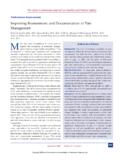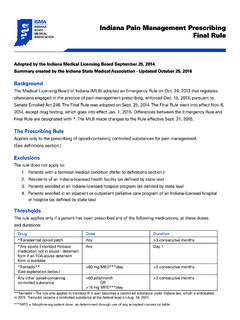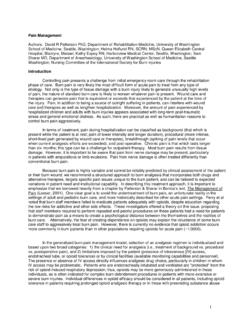Transcription of Pain Management CE - CMS Compliance Group
1 DEPARTMENT OF HEALTH AND HUMAN SERVICES CENTERS FOR MEDICARE & MEDICAID SERVICES pain Recognition and Management Critical Element Pathway Form CMS 20076 (5/2017) Page 1 Use this pathway for a resident who has pain symptoms or can reasonably be expected to experience pain ( , during therapy) to determine whether the facility has provided and the resident has received care and services to address and manage the resident s pain in order to support his or her highest practicable level of physical, mental, and psychosocial well-being, in accordance with the comprehensive assessment and care plan, current professional standards of practice, and the resident s goals and preferences.
2 Review the Following in Advance to Guide Observations and Interviews: Review the most current comprehensive and most recent quarterly (if the comprehensive isn t the most recent) MDS/CAAs for Sections C Cognitive Patterns, G Functional Status, J Health Conditions, K Swallowing/Nutritional Status, L Oral/Dental Status, N Medications, and O Special Treatment/Proc/Prog - dialysis (O100J) or hospice (O100K). Physician s orders ( , pain Management interventions, PRN or routine pain medications, type of pain medications [opioid, non-steroidal anti-inflammatory], and route [injectable, oral, topical]).
3 Pertinent diagnoses. Care plan ( , measurable goals for pain Management , current pain Management interventions, pharmacological and non-pharmacological interventions, timeframes, and approaches for monitoring the status of the resident s pain , including the effectiveness of the interventions). Observations: Does the resident exhibit signs or symptoms of pain , verbalize the presence of pain , or request interventions for pain ? Does the pain appear to affect the resident s function or ability to participate in routine care or activities?
4 If so, describe. For non-verbal or cognitively-impaired residents who cannot verbalize their pain , how does staff assess for the presence of pain and effectiveness of interventions for pain ? If there is evidence of pain , how does staff assess the situation, identify, and implement interventions to try to prevent or address the pain , and evaluate the status of the resident s pain after interventions? If care and services are being provided that reasonably could be anticipated to cause pain , such as therapy, how does staff identify and address these issues, to the extent possible?
5 How does staff respond if there is a report from the resident, family, or staff that the resident is experiencing pain ? If there are pain Management interventions for the resident, how does staff ensure they are implemented as ordered or care planned? What potential adverse consequences associated with treatment for pain ( , medications) does the resident have? How does staff respond if the interventions implemented did not reduce the pain consistent with the goals for pain Management ? How long does the resident wait to receive PRN pain medication after requesting it?
6 DEPARTMENT OF HEALTH AND HUMAN SERVICES CENTERS FOR MEDICARE & MEDICAID SERVICES pain Recognition and Management Critical Element Pathway Form CMS 20076 (5/2017) Page 2 Resident, Resident Representative, or Family Interview: How does the facility involve you in the development of the care plan and defining the approaches and goals? How does the facility ensure the interventions reflect your/the resident s choices and preferences? How are you involved in developing and revising pain Management strategies and revisions to the care plan if the interventions did not work?
7 Describe the characteristics of the pain , including the intensity, pain rating, type ( , burning, stabbing, tingling, aching), patterns of pain ( , constant or intermittent), location, radiation of pain , and frequency, timing, and duration of pain . What factors may precipitate or alleviate the pain ? How have you typically expressed pain and responded to various interventions in the past? Who have you told about the pain /discomfort? How has staff responded? How long does it take for you to receive pain medication when you have asked for it?
8 What treatment options (pharmacological and/or non-pharmacological) were discussed and attempted? How effective have the interventions been? Have you refused any interventions ( , certain types of medications or nonpharmacological ways to reduce pain without medication)? If so, was there a discussion of the potential impact on you, and what alternatives or other approaches were offered? Nursing Aide Interview: Does the resident experience any pain during assistance with activities of daily living?
9 If so, what do you do? Does the resident have any complaints, or exhibit any signs or symptoms of pain ? To whom do you report the resident s complaints and signs or symptoms? Do you know what interventions are on the resident s care plan for pain /discomfort Management ( , allowing a period of time for a pain medication to take effect before bathing or dressing)? Do you implement any interventions to relieve the resident s pain ? Nurse, DON, Hospice Nurse, Attending Practitioner, Pharmacist, Medical Director Interviews: Is there a tool that is used to assess residents with pain ?
10 Is the same tool used for everyone? How is the resident assessed for pain ? How and when do staff try to identify circumstances in which pain can be anticipated? For residents receiving pain medication (including PRN and adjuvant medications), how, when, and by whom are the results of medications evaluated (dose, frequency of PRN use, schedule of How do you monitor for the emergence or presence of adverse events related to opioid medications or the consequences of interventions? For residents with significant, or difficult to manage pain : How were the interventions developed?)












